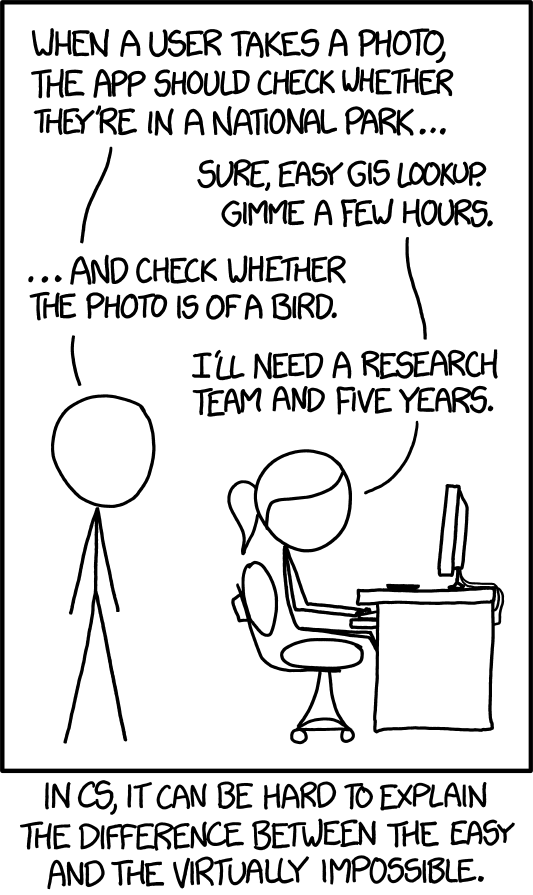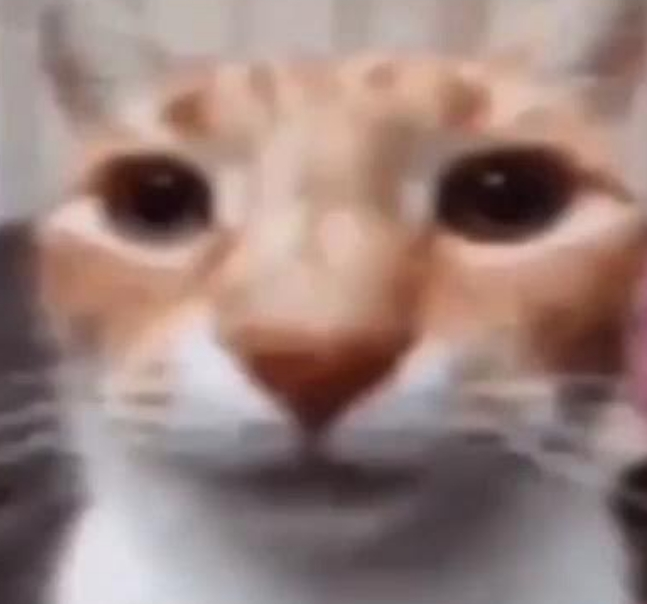We can get a computer to tag the birds, answer questions about them, and generate new pictures of them.
Well research teams have been working on it 10 years
they did good
edit: tbh honest i think it was around 5 years ago i started being able to identify things with google lens on my phone. they worked fast!
They’d already been on it for a few decades 5 years ago…
And crazy how not only can tools recognize birds but generate novel new images of them.
Exactly!
deleted by creator
that’s awesome, didn’t know that
Damn, I wanted to see some parkour birds.
Damn seeing a serious Flickr link truly is a blast from 10 years ago!
Did you miss the part that said “I’ll need a research team and 5 years?” The XKCD character did it! SUCCESS!
More than 5 years then. The comic was right, with the difference that it took more than 1 single team of researchers to solve it
I have a book on learning Pytorch, this XKCD is in the first chapter and implementing this is the first code practice. It’s amazing how things progress.
Do you recommend that book? Title?
Yes I do! It’s a pretty great overview that isn’t extremely math heavy
The book is “Deep Learning for Coders with Fastai and PyTorch: AI Applications Without a PhD”
Thanks! Not math heavy is good.
Not obsolete? More like prophetic.
It’s actually even more correct because it underestimated the time needed by 5 years
The original problem was posited… 60 years ago?
It’s a bit like saying “I wonder how the dinosaurs died?” in the early '00s, a few years before meteor theory really got nailed down. Like, ignore the last century of postulation. We just knocked this out real quick.
Like, ignore the last century of postulation. We just knocked this out real quick.
Oh wow thanks, TIL. I was a kid in the 90s, and always taught and read “there’s many guesses, but the most likely theory is a massive impact causing global changes”. And only today I learnt that it was a relatively new theory at the time, and the crater wasn’t even identified until the early 90s!
The one that blew my mind is that plate tectonics is only a widely accepted theory since the 70s.
yeah, the comic describes it as “the virtually impossible” and directly notes we’ve spent 50 years trying. it’s just a really interesting perspective that it was a recent truism that this stuff is virtually impossible, and we’ve solved it and a huge number of other very difficult problems in less than a decade.
I’m not saying we aren’t building on centuries of work, i’m saying the rate of recent progress is remarkable. I feel like you missed the point on purpose in order to have a hot take.
yeah, the comic describes it as “the virtually impossible”
We are a lot better at it now than we were, say, ten years ago. But it is nearly trivial to outwit a “bird detecting algorithm” by holding up a vague facsimile of a bird. That gets us back to the old TrashFuture line about AI just being “some dude at a computer filling out captchas”.
I’m not saying we aren’t building on centuries of work, i’m saying the rate of recent progress is remarkable.
The recent progress is heavily overstated. More often than not, what a computer does today to recognize a bird is to pull on a large library of data labeled “birds” and ask if there’s a close-enough match. But that large library is not AI driven. Its the consequence of a bunch of manual labeling done by humans with eyes and brains. A novel or rare species of bird, or a bird that’s camouflaged, or even just a bird that’s out-of-focus or badly rendered, will still consistently fail the “Is this a bird?” test.
In short: post title is dumb.
Computer vision was just popping off five years after that, so I would say that it is prescient.
Even with AI models that can identify that there are birds in the picture. Having it decide with accuracy that the picture is of a bird is still a hard problem.
I remember this one. It seems as spot on now as it was then, IMO. It’s not trying to say that object detection is magic or impossible, since it was totally possible then as well. It just requires a dedicated team + time + money to pay them, which is what this comic was trying to express. It is true there are more off-the-shelf software available for newer programmers now than there was before, so dev time is shorter, but that’s more just degrees of comfort / budget as opposed to anything fundamentally different.
That’s true, even if the specific example doesn’t hold, the core concept does. If I needed to implement a bird detector today, I’d make an API call to AWS Rekognition or an equivalent service. It would take me a day or two to learn the API and then maybe 4 hours to actually implement. But if you asked me to implement a bird species detector, I’m pretty sure there is no off the shelf API capable of that, and I would indeed need months or years.
deleted by creator
Google Lens is also a thing for general usage, and there are plenty options for more specific tasks such as Merlin for birds.
It could have been the other way around if global positioning systems were either not developed or used only by the military. In that case, detecting scenery of a park could be easier than trying to figure out the position on the map.
Or it could just be that maps data are not shared. You’ll need to hire boats and hire people to go and draw the map.
yeah and it has been 5 years since the comic and there was a research team that did it
They probably got 2 research teams
I used to put this in my object detection presentations 5 years ago and it never failed to draw chuckles from the audience.
Shit has been going really really fast.
Why do you think it’s obsolete? I suppose nowadays we can use AI generative models to explain the difference between the easy and the virtually impossible, but it still can be hard.
… it’s still true…













